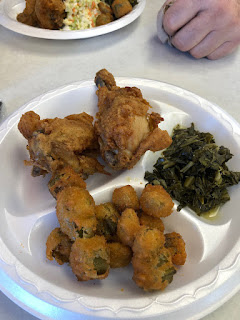Today, we rode to Lake Guntersville, stopping at Lake Guntersville Park on Sunset Drive.
We stopped at McDonald's in Decatur for some apple pies and drinks before heading to Guntersville.
We sat on a bench near the water's edge, and then I heard this pecking sound. I looked up, and to my surprise, I saw a red-headed woodpecker pecking on a rotten tree. He flew from the rotten tree to a Sweetgum tree. I followed it from tree to tree. Then, I spotted a sparrow scratching in the dirt for food. When it saw me, it flew up into the trees.
 |
| Red-headed Woodpecker |
Another of my favorite birds, the downy woodpecker, was aimlessly pecking away on a rotted stump. It was challenging to take a picture because the downy was in shadow, but I managed to get some good photos.
 |
| Downy Woodpecker |
We also saw several Canada Geese, white and spotted ducks, and lots of white terns.
We could hear several fish crows above in the trees. Also saw and heard several bluebirds.
We rode to Marshall County Park, where we saw several ducks and a great gray heron. We also saw a marker of Major Paramoris' Federal Bombardment of Guntersville.
 |
| Major Paramores Federal Bombardment of Guntersville. |
On July 28, 1862, a Federal force under the command of Major J.W. Paramore placed two Parrott guns on the hill. It shelled Guntersville from 7 A.M. to 6 P.M. Captain Cyrus Loomis' First Michigan Battery carried out the shelling, which sent more than one hundred of Guntersville's women and children to the ravine south of town for protection.
The rifled Parrots' guns fired six-pound projectiles greater distances than older smooth-bore cannons and enabled the Yankees to reach across the Tennessee River. Trenches had to be dug to steady the Parrot's guns, which can still be seen atop the hill.
Most shelling concentrated on cotton warehouses and boat construction facilities south of Henry Island, which are now inundated. The Federals attempted to send an attractive force across the river but failed.
As a result of the bombardment, several homes near the riverbank were burned, and many other homes suffered damage from the shells, including the Nickels and Gilbreath residences.
The Chattanooga Daily Rebel reported that the shelling resulted in only two deaths. One was the wife of military General Samuel King Rayburn.











































